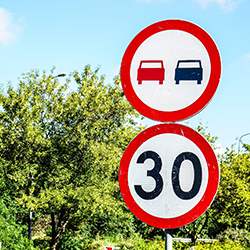Importance of Proper Water Drainage
Effective water drainage is crucial for the longevity and functionality of speed bumps.
Inadequate drainage can lead to water pooling, which not only deteriorates the speed bump material but also poses a hazard to vehicles and pedestrians. To prevent such issues, consider the following points:
- Ensure that the design of the speed bump allows water to flow to the sides rather than accumulating on the surface.
- Regular inspection and maintenance are necessary to keep the drainage channels clear of obstructions.
- Installation should be coordinated with existing drainage systems to optimize water flow and prevent back-ups.
A build-up of dirt and debris can make speed bumps less visible and potentially slippery, reducing their safety benefits. It is essential to maintain a regular cleaning schedule to remove any materials that could impede drainage or visibility.
Integrating Speed Bumps with Road Curbs
The integration of speed bumps with road curbs is a critical aspect of urban design that ensures both functionality and safety.
Proper alignment with curbs allows for seamless water flow and prevents the accumulation of debris. This alignment is essential to maintain the effectiveness of both the speed bumps and the drainage system.
- Ensure that the speed bump’s end points align with the curb’s edge to facilitate water runoff.
- Adjust the height of the speed bump where it meets the curb to avoid creating a barrier to water flow.
- Consider the use of tapered ends on speed bumps to match the curb’s profile, aiding in smoother transitions for vehicles and better water management.
By paying attention to these details, municipalities and installers can prevent water pooling and potential road hazards. The goal is to create a harmonious balance between traffic calming measures and the existing road infrastructure.
Maintaining Drainage Efficiency with Speed Bumps
Ensuring efficient water drainage in areas with speed bumps is crucial to prevent road damage and safety hazards.
Proper installation techniques can help maintain the integrity of the drainage system while still achieving the traffic calming effects of speed bumps.
To maintain drainage efficiency, consider the following steps:
- Align speed bumps parallel to the road’s drainage path to allow water to flow unobstructed.
- Install gaps or channels within the speed bump design to facilitate water passage.
- Regularly inspect and clean the drainage routes around speed bumps to avoid blockages.
Incorporating these strategies not only preserves the road surface but also ensures that the speed bumps continue to perform their intended function without becoming a liability during heavy rainfall or snowmelt.
Navigating Legal and Community Aspects
Understanding Local Regulations and Standards
When considering the installation of speed bumps, it is crucial to
understand local regulations and standards. These rules can vary significantly from one municipality to another, and non-compliance can lead to legal challenges or the removal of the speed bumps.
- Begin by researching the specific requirements for traffic calming measures in your area. This may include permitted dimensions, materials, and locations for speed bumps.
- Consult with local authorities to ensure that your plans align with city or county guidelines. For example, the City of Philadelphia outlines various traffic calming options such as speed cushions and raised crosswalks.
- Obtain any necessary permits or approvals before proceeding with installation. This step is essential to avoid potential fines or enforcement actions.
Engaging with the Community for Support
Gaining community support for the installation of speed bumps is crucial for a smooth implementation process.
Open communication channels are essential to address concerns and gather feedback. Here are some steps to effectively engage with the community:
- Host informational meetings to educate residents about the benefits and potential drawbacks of speed bumps.
- Provide platforms for community members to voice their opinions, such as public forums or online surveys.
- Collaborate with local organizations and neighborhood associations to reach a wider audience.
It’s important to consider the diverse perspectives within the community. By involving residents in the decision-making process, you can foster a sense of ownership and cooperation, which can lead to more successful outcomes. Transparently sharing plans and timelines can also help in building trust and ensuring that the community feels heard and respected throughout the project.
Addressing Safety Concerns and Accessibility Issues
When integrating speed bumps into urban and residential areas,
safety concerns and accessibility issues must be addressed to ensure the well-being of all road users. This includes pedestrians, cyclists, and individuals with disabilities.
- Pedestrian safety is paramount, and speed bumps should be designed to encourage safe vehicle speeds without posing a tripping hazard.
- For cyclists, the design should allow for a smooth transition to avoid accidents.
- Considering individuals with disabilities, speed bumps must not obstruct wheelchair access or create barriers for those with mobility impairments.
In addition to physical design considerations, it’s crucial to incorporate
visual cues that enhance the perception of speed bumps. Research on visual perception can inform the placement of markings and color contrasts that make speed bumps more noticeable to drivers, including those in autonomous vehicles. This not only aids in obstacle recognition but also contributes to the overall safety strategy for all road users.
Conclusion
In summary, speed bumps and humps are crucial traffic calming devices that vary in height, width, and design to suit different road conditions and objectives. Typically, speed bumps have a height of 3 to 4 inches, with low-profile options at 2-3 inches, and a width of less than 1 foot. Speed humps share a similar height but extend about 3 feet across the road. Drainage considerations are also important, especially on roads with curbs, where space is left on either side of the bump for water to flow. Understanding the differences between speed bumps and humps is essential for selecting the appropriate solution to manage vehicle speeds and enhance road safety effectively.

